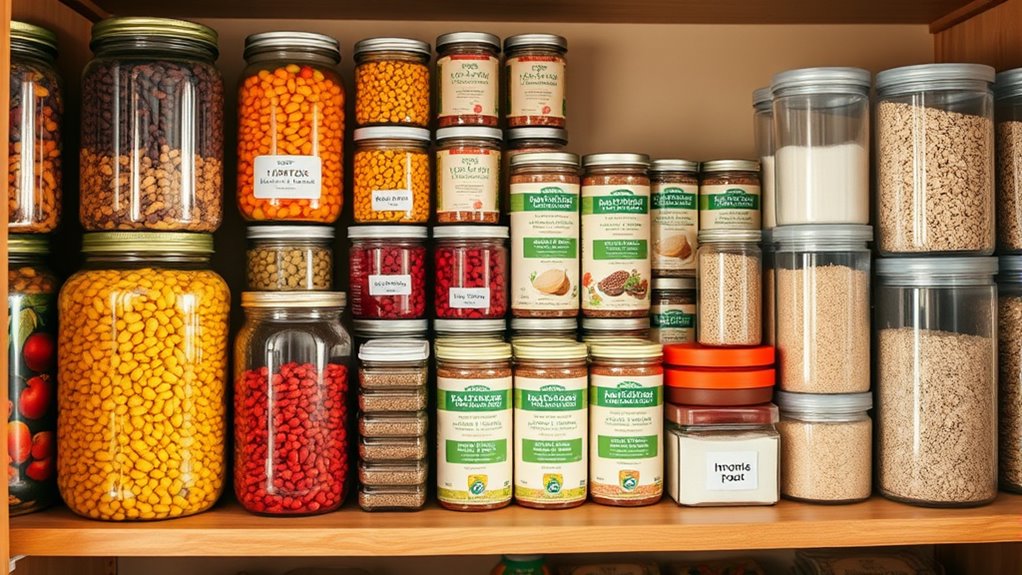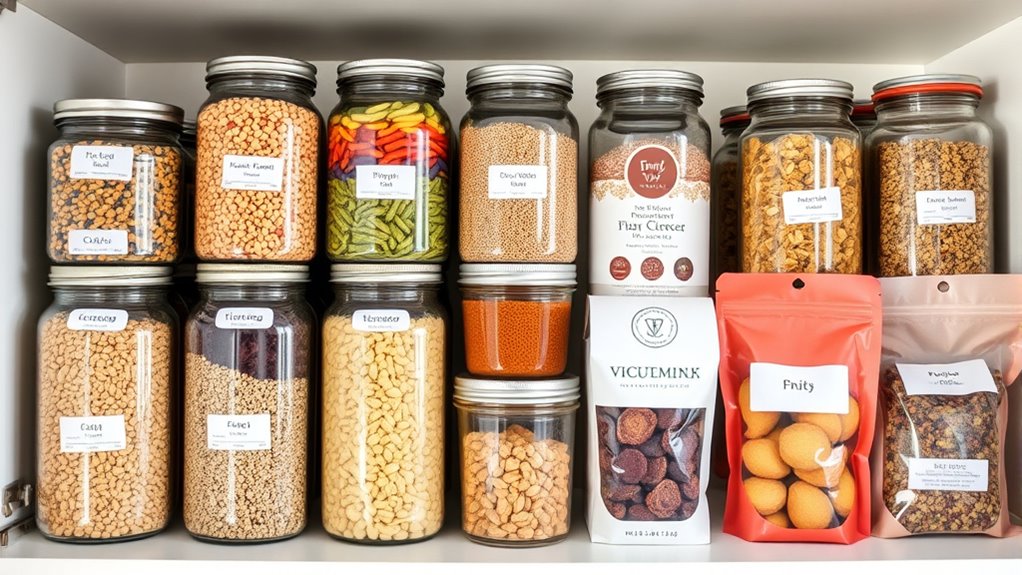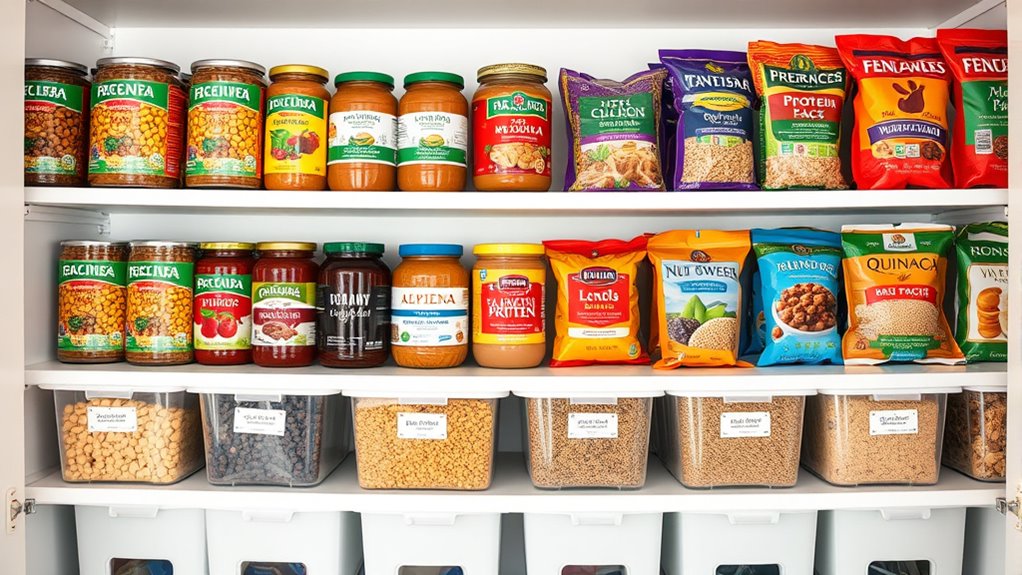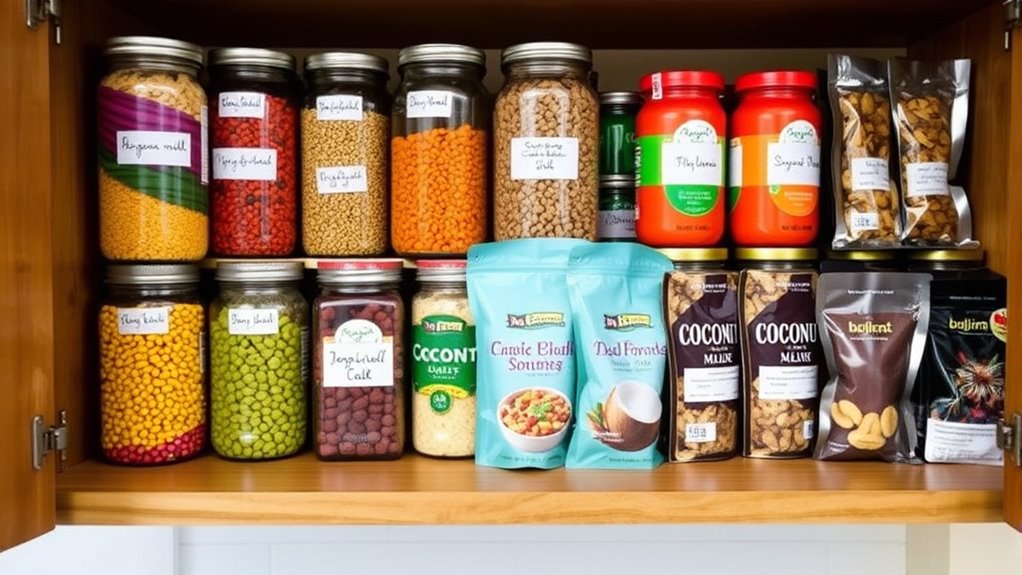To construct a 3-day plant-based emergency pantry, focus on shelf-stable essentials like grains (rice, oats, quinoa), legumes (canned beans, lentils), dehydrated vegetables, and fortified plant milks. Add flavor with spices, sauces, and condiments to keep meals tasty. Pack energy-boosting snacks like dried fruit, nuts, and nut butters. Regularly check expiration dates and store everything in airtight containers in cool, dark areas. If you keep exploring, you’ll learn how to guarantee your supplies stay fresh and reliable.
Key Takeaways
- Stock a variety of long-lasting grains, legumes, canned vegetables, and plant-based proteins for versatile, nutritious meals.
- Use airtight, moisture-proof packaging stored in a cool, dark, dry area to maximize shelf life.
- Incorporate flavor enhancers like spices, herbs, and plant-based sauces to keep meals appealing.
- Prepare simple recipes such as soups, grain bowls, and wraps using shelf-stable ingredients for quick meals.
- Regularly inspect and rotate supplies, replacing expired items and maintaining hydration and emergency essentials.
Essential Components of a Plant-Based Emergency Pantry

Creating a reliable plant-based emergency pantry begins with selecting the right essential components. You’ll want to focus on items that are shelf-stable, nutrient-dense, and easy to prepare. Start by reviewing your emergency supply checklist to guarantee you have enough variety, including grains, legumes, canned vegetables, and plant-based proteins. Prioritize sustainable packaging to reduce waste and affirm freshness; look for options like resealable cans or biodegradable pouches. These packaging choices help you store food efficiently and keep it protected during emergencies. Additionally, include basic seasonings and oils to make meals more flavorful. Incorporating visual cues into your selection process ensures you can properly identify and differentiate food items, reducing the risk of confusion or spoilage. By carefully selecting these components, you’ll build a pantry that’s resilient, eco-friendly, and ready to sustain you through any crisis.
Selecting the Right Staples for Long-Term Storage

When choosing staples for long-term storage, focus on options that provide strong nutritional value to keep you energized. Consider how well they withstand storage conditions and how long they last without spoiling. Additionally, selecting shelf-stable ingredients that can be stored without refrigeration is essential for maximizing shelf life. Also, pick versatile ingredients that can be used in multiple meals to keep your pantry both practical and adaptable. Incorporating proper organization can also help in maintaining an efficient and accessible pantry, ensuring your supplies stay fresh and easy to find over time. Understanding blockchain data management can inspire innovative ways to track and rotate your supplies, preventing spoilage and waste. Selecting items with long shelf life can further maximize your preparedness, reducing the need for frequent restocking.
Nutritional Value Focus
Choosing the right staples for long-term storage means prioritizing foods that deliver essential nutrients while remaining shelf-stable and easy to prepare. Focus on options with clear nutritional labels so you can assess their vitamin, mineral, and protein content. Look for gluten-free options if you or your family have dietary restrictions, ensuring everyone’s needs are met. Prioritize foods rich in protein, fiber, healthy fats, and micronutrients to maintain energy and health during emergencies. Legumes, quinoa, and fortified plant-based milks are excellent choices, providing vital nutrients and versatility. Additionally, selecting nutrient-dense foods with transparent labels helps you monitor micronutrient levels and ensures your emergency pantry supports your health and well-being during stressful situations. Incorporating whole foods that are minimally processed can further enhance your nutrient intake and contribute to a balanced diet.
Storage Conditions & Longevity
Selecting the right staples for long-term storage means paying close attention to how well foods hold up over time. Proper storage conditions extend shelf life and maintain nutritional value. Store dried grains, legumes, and nuts in cool, dark, and dry environments. Use airtight containers to prevent moisture and pests. Consider eco-friendly options like biodegradable packaging for sustainability. For perishable items, solar powered refrigerators can keep items fresh without electricity. Regularly check stored foods for signs of spoilage or damage. Proper labeling helps track expiration dates. Here’s a quick reference:
| Storage Condition | Suitable Staples | Notes |
|---|---|---|
| Cool, dark, dry | Grains, legumes | Prevents spoilage |
| Airtight containers | Nuts, dried fruits | Keeps pests out |
| Refrigeration | Fresh produce, some prepared foods | Use solar powered fridge |
| Packaging | All staples | Biodegradable packaging reduces waste |
Versatility & Meal Options
To guarantee your emergency pantry offers maximum flexibility, focus on staples that can be used in a variety of meals. Using smart food storage techniques ensures your supplies stay fresh and ready to use. Choose versatile ingredients like dried beans, lentils, rice, oats, and canned vegetables that can serve multiple purposes. Incorporate plant-based proteins such as tofu and textured vegetable protein to add variety. When planning your emergency meals, think about combining these staples for soups, stir-fries, or grain bowls. This approach simplifies emergency meal planning and maximizes your options. By selecting adaptable, shelf-stable foods, you’ll be prepared to create nourishing, satisfying meals with minimal effort, no matter the situation.
Tips for Proper Packaging and Storage Techniques

Proper packaging and storage are essential to keep your plant-based emergency pantry fresh and safe. Start by choosing quality packaging materials that protect against moisture, pests, and air exposure. Use airtight storage containers made of glass or BPA-free plastic to preserve freshness and prevent spoilage. Label each container with the contents and date to track shelf life easily. Store dry goods in a cool, dark, and dry place, away from sunlight and humidity, which can degrade food quality. Avoid overpacking containers to allow for expansion or air circulation. Regularly check your pantry for signs of pests or spoilage, and reseal containers tightly after use. Proper packaging and storage techniques guarantee your plant-based pantry remains safe, nutritious, and ready when you need it.
Protein-Packed Plant-Based Options for Emergency Situations

When preparing your emergency pantry, including protein-packed plant-based options guarantees you stay nourished during challenging times. Plant-based protein sources like canned beans, lentils, chickpeas, and shelf-stable tofu provide essential nutrients and versatility. Stocking these items guarantees you can create satisfying meals even when fresh produce isn’t available. Additionally, consider emergency snack ideas such as trail mix with nuts and seeds, peanut or almond butter, and protein bars made from plant ingredients. These options are portable, require no refrigeration, and deliver sustained energy. Incorporating a variety of plant-based proteins guarantees you meet your nutritional needs while maintaining a shelf-stable, plant-centered pantry. Ensuring these items contribute to your nutritional health during emergencies helps you stay healthy and energized. Including nutrition in your emergency supplies ensures you maintain overall health and well-being during any crisis. Being prepared with these protein sources makes it easier to stay healthy and energized during any emergency situation, especially since many of these options also contribute to air purifier features that improve overall air quality in your home. Additionally, selecting cost-effective options can help you build a comprehensive pantry without exceeding your budget.
Carbohydrate and Grain Sources to Keep You Energized

Carbohydrates and grains are essential for maintaining your energy levels during emergencies, providing a reliable fuel source when fresh foods are scarce. To guarantee carbohydrate diversity, stock a variety of grain varieties like rice, oats, quinoa, barley, and millet. These options not only offer different flavors and textures but also supply essential nutrients. Incorporating a mix of whole grains and processed options helps you stay energized and prevents boredom. Keep dried grains, instant oats, and pre-cooked rice on hand for quick meals. By diversifying your grain choices, you’ll be prepared with a range of carbohydrate sources that sustain your energy and support a balanced, plant-based emergency pantry. Vetted options ensure reliable performance and quality in your supplies. Proper storage methods help maintain shelf life and nutritional value for long-term use.
Flavor Enhancers and Condiments to Keep Meals Tasty

Adding plant-based sauces and condiments can instantly elevate your meals and keep them exciting. Stock up on essentials like soy sauce, hot sauce, and nutritional yeast to boost flavor. A few well-chosen spices can also transform simple ingredients into delicious dishes. Regularly inspecting and maintaining your safety equipment ensures your kitchen remains a safe environment during meal prep and emergencies. Incorporating trusted brands known for trustworthiness of Patchology can further ensure the quality and safety of your pantry items. Selecting names inspired by dog names can also add a personal touch to your pet care routine.
Essential Plant-Based Sauces
Plant-based sauces and condiments are essential for keeping your emergency pantry flavorful and versatile. They enhance meals with minimal ingredients and can incorporate fermentation techniques for probiotic benefits or herbal remedies for added health. Stock options like soy sauce, tahini, and tomato paste provide depth and umami. Fermented sauces like miso or vegan kimchi add tang and support gut health. These sauces are shelf-stable and easy to incorporate into various dishes, ensuring your meals stay tasty.
| Sauce Type | Flavor Profile | Shelf Life |
|---|---|---|
| Soy Sauce | Salty, umami | 2+ years |
| Tahini | Nutty, creamy | 6+ months |
| Tomato Paste | Rich, savory | 1+ year |
| Fermented Miso | Salty, umami | 1 year |
| Herbal Infused Sauces | Aromatic, herbal | 6+ months |
Flavor Boosting Spices
To keep your emergency meals flavorful and satisfying, incorporating a variety of shelf-stable spices and condiments is essential. Herbal infusions add depth and brightness to dishes, transforming simple ingredients into tasty meals. Spice blends are convenient, providing multiple flavor notes in one jar, saving space in your pantry. Consider keeping versatile options like cumin, paprika, garlic powder, onion powder, and chili flakes. These can be combined to create custom seasoning blends tailored to your taste. Using herbal infusions, such as dried basil or oregano, boosts flavor without added moisture or perishability. Condiments like soy sauce, tahini, and vinegar also serve as flavor enhancers, making even basic ingredients taste vibrant and satisfying under emergency conditions.
Easy-to-Prepare Recipes Using Shelf-Stable Ingredients

Creating quick and satisfying meals with shelf-stable ingredients is simple when you know how to combine pantry staples. For example, you can make hearty bean and vegetable soups with canned beans, dehydrated vegetables, and vegetable broth. To stay hydrated, include electrolyte mixes or coconut water powder for emergency hydration. Pair your meals with shelf-stable grains like rice or pasta, which are easy to prepare. Don’t forget to keep essential first aid supplies nearby—these are vital during emergencies. You can also create nutritious wraps using dehydrated veggie powders and spreads. These recipes are not only quick but also reliable, ensuring you get balanced nutrition without sacrificing shelf life. Proper storage techniques are essential to maintain the quality and safety of your emergency pantry items. With a little planning, your pantry can support delicious, emergency-ready meals anytime.
Rotating and Maintaining Your Emergency Supplies

Regularly rotating and maintaining your emergency supplies guarantees they stay fresh and ready to use when needed. To do this effectively, consider these steps:
Regular maintenance keeps your emergency supplies fresh, reliable, and ready when you need them most.
- Check expiration dates on shelf-stable foods and replace anything nearing expiry.
- Rotate emergency hydration supplies, ensuring water containers are sealed and fresh.
- Restock first aid items, replacing used or expired supplies to keep your kit ready.
- Inspect packaging for damage or leaks, resealing or discarding compromised items.
Consistent maintenance ensures your pantry remains reliable during emergencies. Keep an eye on your supplies and update them as needed, especially for first aid essentials. Proper rotation minimizes waste and guarantees that when you need your emergency kit, everything is fresh, functional, and ready to support your health and safety.
Additional Items to Consider for Comfort and Nutrition

Adding a few comfort and nutrition items to your emergency pantry can make a tough situation more manageable. Comfort snacks like dried fruit, trail mix, or nut butter provide a quick boost of energy and boost morale. Including emergency beverages such as herbal teas, electrolyte drinks, or flavored water guarantees you stay hydrated and comforted. These items help maintain your well-being and provide a sense of normalcy during stressful times. Choose plant-based options that are shelf-stable and easy to store, avoiding perishables. Incorporate a variety of flavors and textures to keep your spirits up. Having these small but essential items offers both physical nourishment and emotional comfort, making your 3-day emergency plan more resilient and reassuring.
Frequently Asked Questions
How Long Can a Plant-Based Emergency Pantry Realistically Last?
You can expect a plant-based emergency pantry to last about 1 to 2 years with proper storage duration and preservation techniques. Store items in a cool, dry, dark place to prevent spoilage. Using vacuum sealing or airtight containers helps extend shelf life. Regularly check expiration dates and rotate stock to keep your pantry fresh and ready for emergencies, ensuring reliable food availability when you need it most.
Are There Any Specific Allergy Considerations for Shelf-Stable Plant Foods?
Think of allergenic ingredients in shelf-stable plant foods like hidden landmines. You need to watch out for common allergens like nuts, soy, and gluten, which can cause serious reactions. Cross-contamination risks are also high if products aren’t stored separately or processed on shared equipment. Always read labels carefully, choose certified allergen-free options when possible, and keep your emergency pantry safe for your specific allergies.
Can I Include Fresh Produce in My Emergency Pantry?
You might wonder if fresh produce fits in your emergency pantry. While fresh produce is nutritious, it isn’t ideal for long-term storage because it spoils quickly. Instead, focus on shelf-stable options like dried fruits and vegetables. If you want to include fresh produce, use proper storage techniques—like refrigeration or vacuum sealing—to extend its shelf life. Keep in mind, though, that non-perishable items are better for emergencies.
What Are the Best Storage Temperatures for Plant-Based Shelf-Stable Items?
Did you know that proper storage temperatures can extend shelf life by up to 50%? For plant-based shelf-stable items, aim for a cool, dark spot between 50-70°F (10-21°C). Good food preservation relies on consistent storage techniques, so avoid temperature fluctuations. Keep items away from direct sunlight, heat sources, and humidity to maintain freshness and nutritional value, ensuring your emergency pantry stays reliable when you need it most.
How Can I Ensure Variety in a Limited Plant-Based Emergency Pantry?
To guarantee variety in your limited plant-based emergency pantry, focus on nutritional diversity and flavor variety. Include different types of beans, lentils, grains, and dried fruits to boost nutrients. Add spices, herbs, and flavored oils to keep meals interesting. Rotate items regularly to maintain freshness, and consider easy-to-prepare options like instant soups or veggie stews. This approach keeps your pantry both nutritious and enjoyable during emergencies.
Conclusion
With a thoughtfully chosen, plant-based pantry, you’ll effortlessly navigate unexpected moments. By keeping your supplies fresh and well-organized, you’re gently nurturing resilience and peace of mind. Remember, small steps today create a foundation of comfort tomorrow. Embrace the journey of preparedness, knowing that each carefully stored item adds a touch of reassurance. In your quiet readiness, you’ll find the strength to face whatever comes, with kindness and confidence guiding your way.










